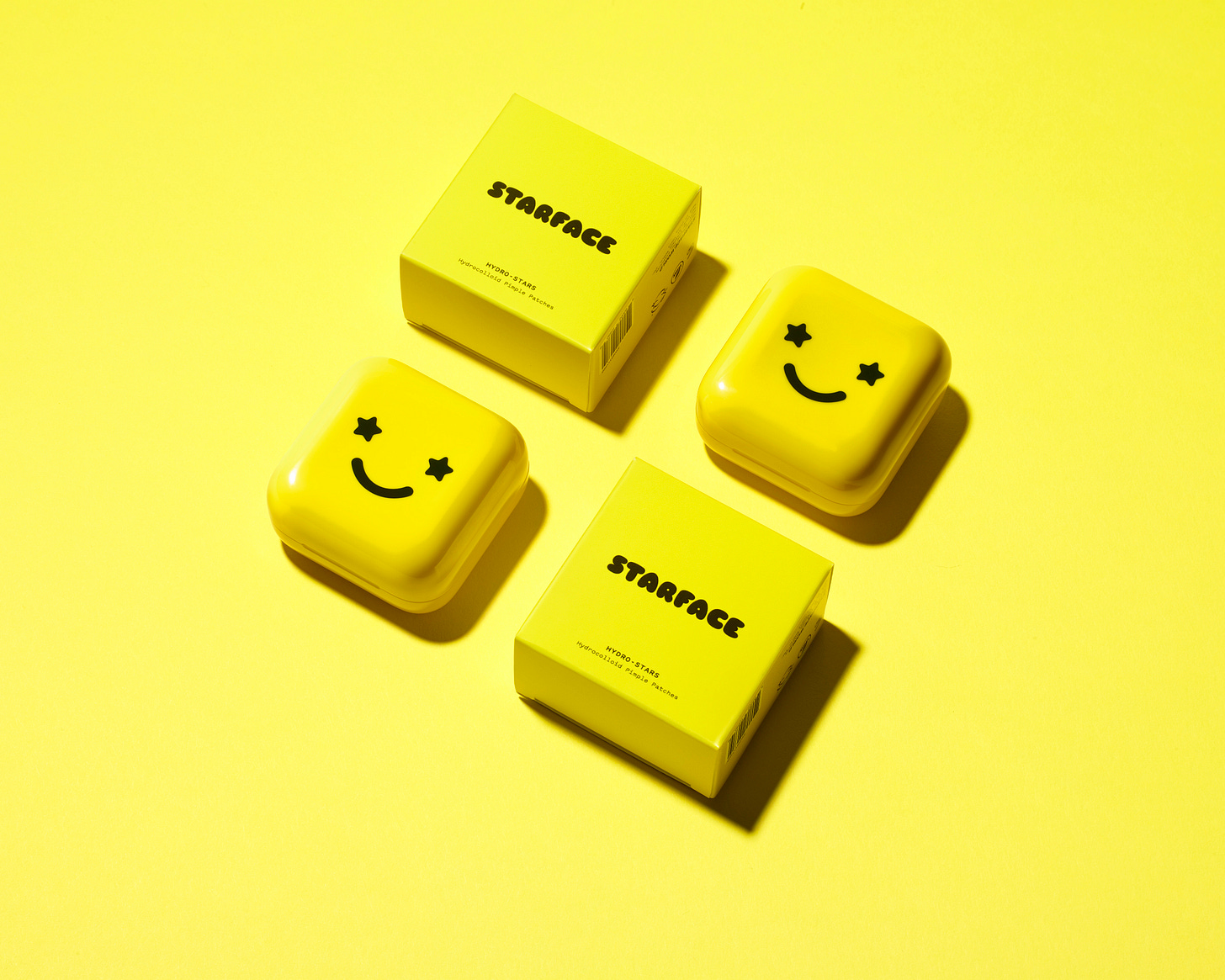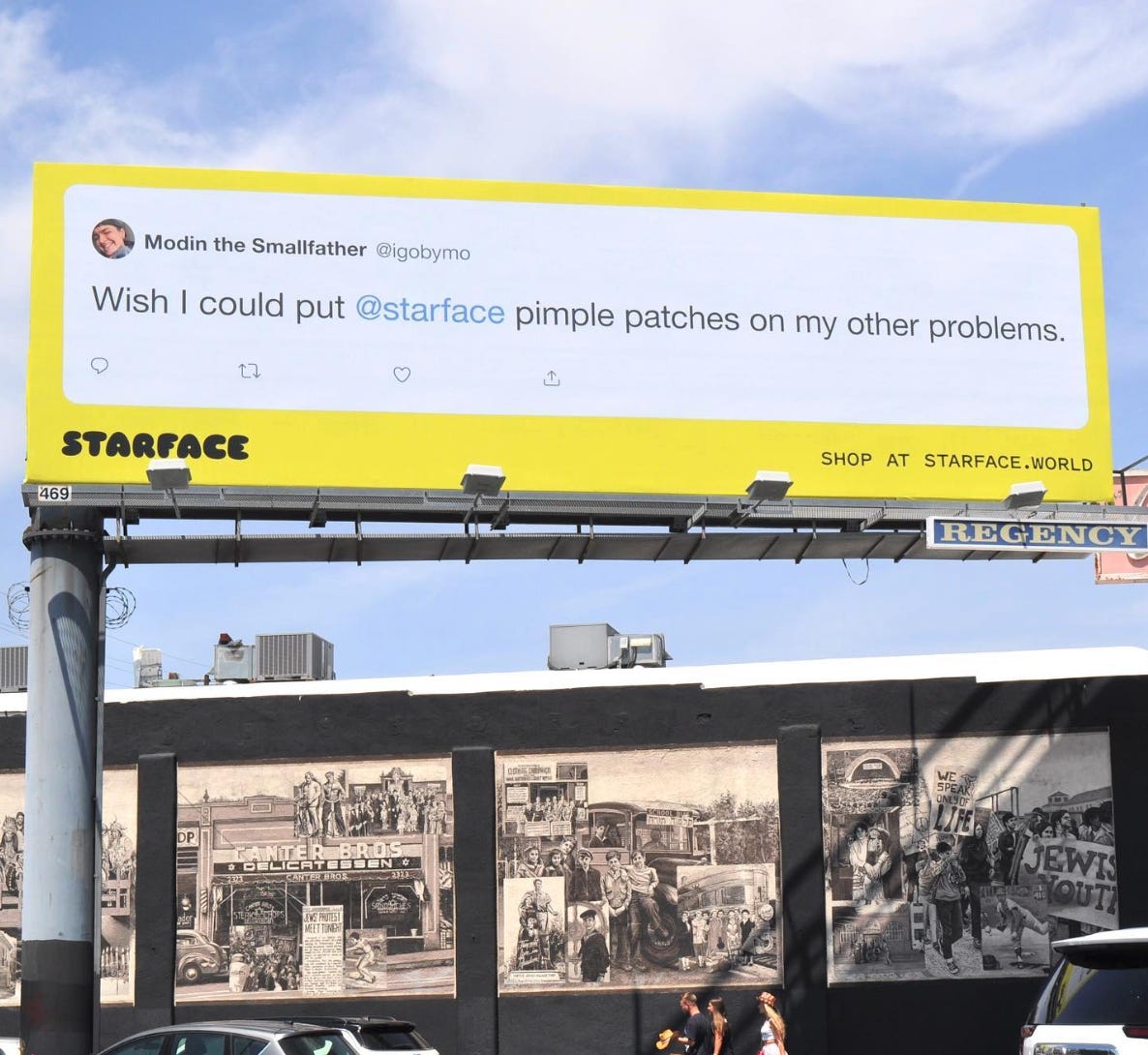How Starface Used Clever Positioning, Creative Strategy and Culture Forward Collabs to Turn Pimple Patches into a Brand for Gen Z (and $90M a Year in Revenue)
⌚️ Read time: Just 6 minutes
Starface is a prime example of a built-for-the-internet brand that’s mastered the art of the reframe and a pitch perfect very online creative strategy to ride a cultural shift to an estimated $90M a year in revenue
👋 Hi, I'm Amanda. I'm a brand strategist and fractional CMO. I help founder-led businesses turn belief into brand—and brand into a strategic asset that works as hard as you do. I share weekly deep dives with actionable advice on brand building—plus interviews with the people in the trenches. I also work 1:1 with founders and teams. Book a chat here.
Who will love this
Clearasil OGs
Skincare fanatics
Concealer-haters
Gen-Z brand builders
E-comm enthusiasts
Today
Good morning from Cannes 🍸🫡
Just kidding. I’m writing this from a couch in Seattle.
🔥 Hot take alert: I’m not a fan of discussions about ‘how to market to Gen-(insert generation here). I think it’s an oversimplification of the messy identities we all claim: yes, I’m a millennial, but I’m also a runner, a marketer, a coach, Swiftie, Seattle-ite, etc.
That being said - today’s brand is one that’s squarely aimed at Gen Z.
Starface is a pimple patch brand coherent, fresh, fun, and importantly - designed for the internet. If I were building a skincare brand or anything that was trying to capture a Very Online audience, I’d be paying attention to this pimple patch brand have positioned and marketed themselves.
At just under 5 years old, it’s a relative newcomer to market. Fresh-outta-the-oven brands give us an opportunity to look at brands devoid of baggage, and look at whether the brand is helping or hurting the growth of a business. In this case, it’s safe to say Starface’ brand is a tremendous accelerant to growth.
Let’s get into it ⭐
Amanda
Community Playback: Spring Energy
Thanks for the replies to the Spring Energy post last week! If you missed it, last week I wrote about a brand that’s doing just about everything you shouldn’t do in a brand crisis, and asked you what you would do.
General sentiment from y’all (and Reddit) was that Spring Energy should:
Admit fault
Share checks and balances to make sure it doesn’t happen again
Created some sort of ‘make good’ for anyone who’s purchased the pricey (and mislabelled) products
What they actually did: Deleted their apology post and have started an aggressive runfluencer content strategy. 🤦♀️
If I were Gatorade, or Gu (or a Spring Energy investor), I’d be very interested in exploring a Spring Energy acquisition. Based on how they’ve handled things so far, I think they’ll need deep pockets and the assurance that comes with a major food manufacturer to rebuild trust with ultra-runners.
Moving on!
How Starface Built a Skincare Brand for Gen-Z to Turn Spots into Stars
Backstory (How it started)
Starface, launched in 2019, makes Instagrammable star-shaped hydrocolloid pimple patches. But they’re not just any pimple patches: they’ve been worn by Justin Bieber, Florence Pugh, Hailey Bieber, Bella Hadid, Dua Lipa, Willow Smith, and on the runway at New York Fashion week. Pimples are…in!?
Brand strategy (Who Starface is)
So how’d they go from zero to zeitgeist? Starface is a case study in positioning, creative strategy, and harnessing a culture shift. It isn’t skincare, it’s self-expression. They’re not marketing, they’re making memes. And we’re not covering up our flaws anymore, we’re embracing them. Showing people leveraging the product as self expression begets more self expression - and the flywheel spins. Here are the core components I see in their brand strategy 👇
Audience: people with pimples, tired of seeking perfection: Love it or hate it, Gen Z are known for their authenticity, which is exactly what Starface founder Julie Schott has played into: the understanding that younger people don’t trust the perfect life that brands used to promise people. As someone who grew up in the supermodel era, I ship this 📦
Positioning: skincare as self-expression: When I look at Starface, I see a brand that’s behaving more like a fashion brand than a skincare brand. The limited edition drops. The zeitgeist-y mood films. The collabs with cultural influencers (like this one with @SylvanianDrama, a series-based TikTok that stages unhinged and humorous skits using Sylvanian Family figurines from the 80s).
Brand expression: born to stand out. Starface have a remarkably coherent identity: the name, the color, the tone of voice, the positioning - they all work. Millennial pink, move over. Starface’s neon yellow packaging is a throughline of the brand (what my marketing effectiveness crew would call a distinctive asset). Replace “distinctive asset” with “mental shortcut” and that’s how branding works, to radically simplify things.
Creative strategy: leverage internet culture with UGC. Starface is a brand that’s embraced ‘very online’ culture as part of their creative strategy, and for good reason: that’s where their customers are. Founder Julie worked as a beauty writer for online magazine xojane, where she watched online trends play out. She’s obviously hired well and cultivated an environment that’s conducive to shipping the type of work that resonates online - not something every organization can pull off.
“It was a really different time online. Instagram wasn’t around. It wasn’t about competing to be a lifestyle guru. Everyone who was experiencing acne would all just talk to each other in the comments.” - Julie Schott, on her time working at xojane
Brand marketing moves (How Starface are telling the world who they are)
Acne as a fashion moment. How do you position pimple patches as self-expression? Get those patches up in lights at New York Fashion week! Starface partnered with the makeup artist Fara Homidi to launch the brand’s Black Star patches in the fall of 2022 at the Puppets and Puppets NYFW 2022 fashion show, nabbing a great headline (first pimple patch to ever walk a fashion week runway) and crystallizing the cultural shift in embracing acne through self-expression. Smart.
Limited edition drops. Starface has mastered the art of generating demand with limited edition drops, partnering with Sesame Street, SpongeBob SquarePants and Hello Kitty (currently listed on the website, but sadly, sold out) to create limited runs of Starface patches.
Standing with younger generations. Starface became one of the first brands to partner with student athletes following a landmark Supreme Court decision to allow college athletes to receive education-related compensation, partnering with #5 NFL draft pick Kayvon Thibodeaux and carrying out their mission ‘to make growing up and finding yourself more fun.’
Making drivers license photos suck less. Starface turned up to select DMV locations and targeted young people waiting to get their license. I just love this.
Passing the mic. Starface really leaned into the UGC by launching a billboard contest and giving customers the chance to turn their content into billboards in LA and NYC. I love this.
Bottom Line (How it’s going)
Business is (reportedly) booming. Starface is a private company so we can’t dig into their financials, but Puck reported that the brand was on track to hit $90M in revenue, according to people with access to point of sale data.
What can we learn from Starface?
Starface have clear positioning, a fresh identity, and a hardworking marketing strategy that’s squarely aimed at their customer (who they really understand). What I love most about their strategy is that it demonstrates a few things that are core to effective brand strategy:
💰 Brand is a lever for pricing power. Starface is proof of the pricing power of brand. CVS pimple patches cost $8.99. Starface are $11.99. That margin is all brand, baby.
🧐 Don’t underestimate the art of the reframe. Good marketers love a reframe. Starface’s product is truly innovative, but that’s not because it’s a hydrocolloid patch - it’s because of it’s positioning and where that positioning allows them to go.
👯 Getting other people talking about you > you talking about you. Lots of brands say “we want other people to talk about us.” Not many brands do things worth talking about. Starface does. Notably, this comes from a really deep understanding of their customer.
👀 Brand Scoops Catching my Eye This Week
This kind-of-unhinged KFC spot, ‘Believe in Chicken’ - I said it last week and I’ll say it again: choreography is a sick creative tool that not enough people are using.
This Adidas spot that Edward Cotton shared on LinkedIn. Goosebumps. Related: I’m dying to know how much cash they shelled out for the rights to Hey Jude? Masterful.
Liquid Death ‘terminating’ their relationship with The Deep, a character from Amazon Prime series ‘The Boys’ who Liquid Death have cleverly (as ever) brought into their brand world
This Acquired podcast on Starbucks. No one’s better at writing and rewriting a company’s narrative than Howard Schulz & he’s doing it again here. If you’re a founder or interested in founder marketing, get the ~3 hour (no joke!) pod here.
That’s all from me today! Thanks for reading. If you loved this piece, consider forwarding it to someone who’s making the commercial case for brand or replying and letting me know what you thought about it.
Was this message forwarded to you? Need to make the case for brand? Sign up below 👇
Questions? Hot takes? Brands you want to see covered? Hit ↩️ reply.






